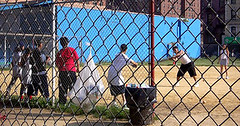Looking at all our resources
 Children playing baseball in Harlem. Photo from Gotham Gazette.
Children playing baseball in Harlem. Photo from Gotham Gazette.Speaking of laments, I have been "complaining" that simultaneous planning initiatives in the City of Washington:
1. DC Comprehensive Plan Revision;
2. DC Public Schools;
3. DC Parks and Recreation;
4. DC Public Libraries;
demonstrate the need for a true "comprehensive planning process" and organization, rather than what I have been calling an "office of land use."
For the most part, each of these efforts is disconnected.
As an example, I have been making the point that schoolyards are potential park resources, but not to a school system that sees its role in a limited fashion, and definitely not to the very parochial parks department.
The Gotham Gazette, publication of the Citizens Union Foundation of New York City (and one of the models for a relaunched Citizens Planning Coalition), has an article about "Creating a Healthy Future for Harlem and New York City," and it includes this sidebar, by NYC City Councilwoman Gale Brewer, which discusses why "Public School Yards Should Be Open to the Public":
On weekdays, the schoolyard at PS 9 on West 84 Street in Manhattan buzzes with students climbing on the jungle gym, skipping rope, and playing basketball. But on the weekends, the scene is different; the playground is empty and the gate to the yard is locked.
It was not always this way. In years past, the schoolyard was open on evenings and over the weekends and neighbors used the area as a place to play with their children and to meet with one another.
This is also the case in more than 700 other schoolyards across the city. All of the underutilized schoolyards occupy approximately 948 acres of public land - an area greater than that of Central Park.
Despite a clear lack of recreational open space for residents, the Department of Education has closed most of its schoolyards to the public during the evenings and on weekends. In fact, 73 percent of all Department of Education schoolyards lie empty when school is not in session.
The citywide closure of playgrounds has occurred only in the last ten years. The exact rationale for closing schoolyards to the public seems to be unclear, but in most cases, the policy has persisted with little resistance.
And although the majority of schoolyards are closed to the public outside of school hours, roughly 300 schoolyards across the city do remain available to the public when children are not in the building. The majority of these are operated by the Department of Parks and Recreation, although additionally almost 25 have been “adopted” for operation by the Trust for Public Land, a national nonprofit land conservation organization.
As more and more families are denied access to outdoor recreational spaces, it has become increasingly challenging for parents to promote their children's physical health.
Designating or creating new public space in New York City is an enormous challenge, requiring us to be creative in our effort to provide residents of all neighborhoods with access to adequate recreational facilities.
Let's open our public spaces to the public and give New Yorkers the space they need.
This is but one example of the costs that come from considering public assets very narrowly, within the confines of the particular agencies that control these assets, even though the assets should be thought of more broadly, as belonging to the citizens, but managed and "stewarded" by the particular agency.
Index Keywords: public-assets



0 Comments:
Post a Comment
<< Home